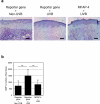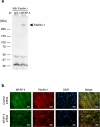Essential role of microfibrillar-associated protein 4 in human cutaneous homeostasis and in its photoprotection
- PMID: 22355679
- PMCID: PMC3240987
- DOI: 10.1038/srep00164
Essential role of microfibrillar-associated protein 4 in human cutaneous homeostasis and in its photoprotection
Abstract
UVB-induced cutaneous photodamage/photoaging is characterized by qualitative and quantitative deterioration in dermal extracellular matrix (ECM) components such as collagen and elastic fibers. Disappearance of microfibrillar-associated protein 4 (MFAP-4), a possible limiting factor for cutaneous elasticity, was documented in photoaged dermis, but its function is poorly understood. To characterize its possible contribution to photoprotection, MFAP-4 expression was either augmented or inhibited in a human skin xenograft photodamage murine model and human fibroblasts. Xenografted skin with enhanced MFAP-4 expression was protected from UVB-induced photodamage/photoaging accompanied by the prevention of ECM degradation and aggravated elasticity. Additionally, remarkably increased or decreased fibrillin-1-based microfibril development was observed when fibroblasts were treated with recombinant MFAP-4 or with MFAP-4-specific siRNA, respectively. Immunoprecipitation analysis confirmed direct interaction between MFAP-4 and fibrillin-1. Taken together, our findings reveal the essential role of MFAP-4 in photoprotection and offer new therapeutic opportunities to prevent skin-associated pathologies.
Figures








Similar articles
-
Rosemary extract and rosmarinic acid accelerate elastic fiber formation by increasing the expression of elastic fiber components in dermal fibroblasts.J Dermatol. 2024 Jun;51(6):816-826. doi: 10.1111/1346-8138.17185. Epub 2024 Mar 12. J Dermatol. 2024. PMID: 38470170
-
Fibrillin-rich microfibrils are reduced in photoaged skin. Distribution at the dermal-epidermal junction.J Invest Dermatol. 1999 May;112(5):782-7. doi: 10.1046/j.1523-1747.1999.00562.x. J Invest Dermatol. 1999. PMID: 10233772
-
The endogenous protease inhibitor TIMP-1 mediates protection and recovery from cutaneous photodamage.J Invest Dermatol. 2012 Dec;132(12):2800-9. doi: 10.1038/jid.2012.204. Epub 2012 Jun 21. J Invest Dermatol. 2012. PMID: 22718114
-
Photoaging of the skin from phenotype to mechanisms.Exp Gerontol. 2000 May;35(3):307-16. doi: 10.1016/s0531-5565(00)00098-x. Exp Gerontol. 2000. PMID: 10832052 Review.
-
Marfan syndrome: new clues to genotype-phenotype correlations.Ann Med. 1999 Jun;31(3):202-7. doi: 10.3109/07853899909115979. Ann Med. 1999. PMID: 10442675 Review.
Cited by
-
microRNA-449a functions as a tumor suppressor in neuroblastoma through inducing cell differentiation and cell cycle arrest.RNA Biol. 2015;12(5):538-54. doi: 10.1080/15476286.2015.1023495. RNA Biol. 2015. PMID: 25760387 Free PMC article.
-
Effect of red ginseng NaturalGEL on skin aging.J Ginseng Res. 2020 Jan;44(1):115-122. doi: 10.1016/j.jgr.2018.09.006. Epub 2018 Oct 6. J Ginseng Res. 2020. PMID: 32148394 Free PMC article.
-
Quantitative Comparative Proteomics Reveal Biomarkers for Dengue Disease Severity.Front Microbiol. 2019 Dec 10;10:2836. doi: 10.3389/fmicb.2019.02836. eCollection 2019. Front Microbiol. 2019. PMID: 31921022 Free PMC article.
-
Microfibril-associated glycoprotein 4 forms octamers that mediate interactions with elastogenic proteins and cells.Nat Commun. 2024 May 13;15(1):4015. doi: 10.1038/s41467-024-48377-z. Nat Commun. 2024. PMID: 38740766 Free PMC article.
-
Transcriptional Profiling Identifies Prognostic Gene Signatures for Conjunctival Extranodal Marginal Zone Lymphoma.Biomolecules. 2023 Jan 6;13(1):115. doi: 10.3390/biom13010115. Biomolecules. 2023. PMID: 36671500 Free PMC article.
References
-
- Crutzen P. J. Ultraviolet on the increase. Nature 356, 104–105 (1992).
-
- Slaper H., Velders G. J. M., Daniel J. S., De,.Gruijl F. R. & Van, der, Leun J. C. Estimates of ozone depletion and skin cancer incidence to examine the Vienna Convention achievements. Nature 384, 256–258 (1996). - PubMed
-
- Scharffetter-Kochanek K. et al.. UV-induced reactive oxygen species in photocarcinogenesis and photoaging. Biol. Chem. 378, 1247–1257 (1997). - PubMed
-
- Nakagawa H. Cutaneous aging processes. J. Japanese Cosmetic Science Society 24, 120–123 (2000).
-
- Braverman I. M. & Fonferko E. Studies in cutaneous aging: 1. The elastic fiber network. J. Invest. Dermatol. 78, 434–443 (1982). - PubMed
MeSH terms
Substances
LinkOut - more resources
Full Text Sources
Other Literature Sources
Molecular Biology Databases
Miscellaneous

